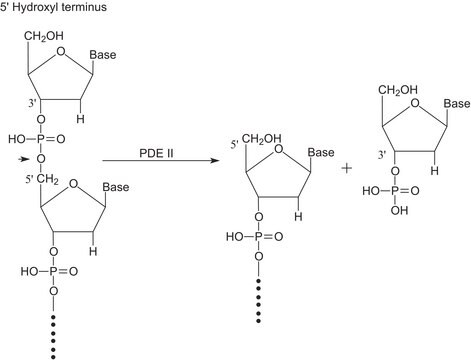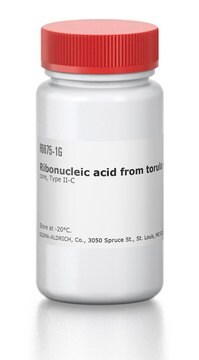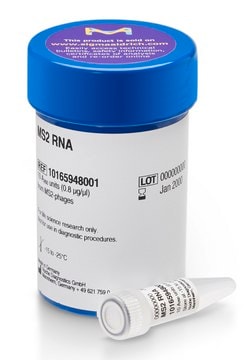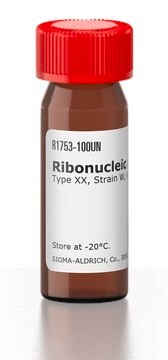R6625
Ribonukleinsäure aus Torulahefe
Type VI
Synonym(e):
RNA
Anmeldenzur Ansicht organisationsspezifischer und vertraglich vereinbarter Preise
Alle Fotos(3)
About This Item
Empfohlene Produkte
Suchen Sie nach ähnlichen Produkten? Aufrufen Leitfaden zum Produktvergleich
Allgemeine Beschreibung
Ribonukleinsäure (RNA) aus Torula-Hefe ist das Substrat für das RNase-Enzym. Die Isolierung von RNA aus Hefe ist ein kompliziertes Verfahren und involviert Zyklen von Erwärmen und Einfrieren von Zellen in Gegenwart von Phenyl und Detergenzien (SDS).
Anwendung
Ribonukleinsäure (RNA) eignet sich für Anwendungen wie Northern-Blot-Hybridisierung, Reverse-Transkriptase-Polymerase-Kettenreaktion (RT-PCR) und cDNA-Konstruktion.
Ribonukleinsäure (RNA) aus Torula-Hefe kann als Substrat zur Untersuchung der Ribonukleaseaktivität von Enzymen wie Ribonuklease-A, Ribonuklease T1 (RNase) und des antiviralen Proteins 1 der Bougainvillea x buttiana (BBAP1) verwendet werden.
Ribonukleinsäure (RNA) aus Torula-Hefe kann als Substrat zur Untersuchung der Ribonukleaseaktivität von Enzymen wie Ribonuklease-A, Ribonuklease T1 (RNase) und des antiviralen Proteins 1 der Bougainvillea x buttiana (BBAP1) verwendet werden.
Qualität
Phosphor: 8,0–10,0 % (wasserfrei)
Lagerklassenschlüssel
11 - Combustible Solids
WGK
WGK 3
Flammpunkt (°F)
Not applicable
Flammpunkt (°C)
Not applicable
Persönliche Schutzausrüstung
Eyeshields, Gloves, type N95 (US)
Analysenzertifikate (COA)
Suchen Sie nach Analysenzertifikate (COA), indem Sie die Lot-/Chargennummer des Produkts eingeben. Lot- und Chargennummern sind auf dem Produktetikett hinter den Wörtern ‘Lot’ oder ‘Batch’ (Lot oder Charge) zu finden.
Besitzen Sie dieses Produkt bereits?
In der Dokumentenbibliothek finden Sie die Dokumentation zu den Produkten, die Sie kürzlich erworben haben.
Kunden haben sich ebenfalls angesehen
Jay S Petrick et al.
Regulatory toxicology and pharmacology : RTP, 81, 57-68 (2016-10-30)
Genetically modified (GM) crops have been developed and commercialized that utilize double stranded RNAs (dsRNA) to suppress a target gene(s), producing virus resistance, nutritional and quality traits. MON 87411 is a GM maize variety that leverages dsRNAs to selectively control
Michael R Green et al.
Cold Spring Harbor protocols, 2021(12) (2021-12-03)
Isolation of RNA from yeast is complicated by the need to first break the thick, rigid cell wall. The protocol provided here uses a cycle of heating and freezing of cells in the presence of phenol and the detergent sodium
E S Trombetta et al.
The Journal of cell biology, 148(6), 1123-1129 (2000-03-22)
Newly synthesized glycoproteins interact during folding and quality control in the ER with calnexin and calreticulin, two lectins specific for monoglucosylated oligosaccharides. Binding and release are regulated by two enzymes, glucosidase II and UDP-Glc:glycoprotein:glycosyltransferase (GT), which cyclically remove and reattach
Stephanie L Grillo et al.
Purinergic signalling, 15(3), 327-342 (2019-07-06)
Adenosine is an endogenous nucleoside in the central nervous system that acts on adenosine receptors. These are G protein-coupled receptors that have four known subtypes: A1, A2A, A2B, and A3 receptors. In the present study, we aimed to map the
Jesus E Martinez-Lopez et al.
Frontiers in neuroanatomy, 9, 12-12 (2015-03-06)
In the study of central nervous system morphogenesis, the identification of new molecular markers allows us to identify domains along the antero-posterior and dorso-ventral (DV) axes. In the past years, the alar and basal plates of the midbrain have been
Unser Team von Wissenschaftlern verfügt über Erfahrung in allen Forschungsbereichen einschließlich Life Science, Materialwissenschaften, chemischer Synthese, Chromatographie, Analytik und vielen mehr..
Setzen Sie sich mit dem technischen Dienst in Verbindung.








